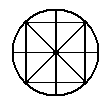
1. Hare game (medium)

1. Hare game (medium)
This is a traditional form of hunt game that almost uniformly uses three pieces versus one. The three yellow pieces cannot move in the backward directions (northwards). They must try to stalemate the red piece. Neither side can capture. Red (the hare) must try to get behind the yellow dogs. Note that the hare party loses if position is repeated three times. Win is achieved when the hare reaches the apex, or before.
Hare games were common in northern Europe, but are today almost forgotten. H. J. R. Murray (A History of Board-Games) doesn’t mention them. The game has its roots in medieval times. As described by Andris Caune, small boards (fig. 2 and fig. 5) have been found in Latvia, deriving from ca. 1300. References to them occur throughout Scandinavia.
The names of the pieces vary (it’s not always dogs against a hare). In Great Britain traditional names are uncertain, but Hare and hounds, Game of Dwarves, or The Devil among tailors occur. In Denmark it was often called Haretavl, and in Sweden Hare och hund, Trevolpa or Volpalejden (Valpleken). In France, 1886, a small board game was reintroduced under the name of The Soldiers’ Game (fig. 2). It became very popular in military circles during and after the French-German war in 1870-71. (The variant is described in Scientific American, Oct. 1963, pp. 124-130.)
The variants in fig. 1, 2 and 3 function finely and are tricky games. Diagrams 1 and 3 derive from Berlekamp, et al, 1982, but rules are here somewhat improved. Certain historical game diagrams seem defunct. Possibly it had the character of ritual, or came to be regarded as a children’s game; so it didn’t matter. The hare is either dropped onto the board in the first move, or is positioned already. Dropping the hare increases variability, and is perhaps preferable if the board pattern so allows.
 2. “The Soldiers’ game”, or small Hare game.
In this variant the dogs are placed on
the upmost squares, but the hare is
dropped on any empty square in the
first move
2. “The Soldiers’ game”, or small Hare game.
In this variant the dogs are placed on
the upmost squares, but the hare is
dropped on any empty square in the
first move
 3. A large Hare game that functions finely.
3. A large Hare game that functions finely.
 4. The “Game of Dwarves” or “Catch the Giant”,
using a simplified board (after Schuh, 1968).
In order for this to work, I place the hare
between the dogs, with the dogs to move.
4. The “Game of Dwarves” or “Catch the Giant”,
using a simplified board (after Schuh, 1968).
In order for this to work, I place the hare
between the dogs, with the dogs to move.
 5. A board from Riga, Latvia (ca 1300).
But it doesn’t seem to work. Either it’s
trivial or the hare wins (and it can’t be
a merels board.)
5. A board from Riga, Latvia (ca 1300).
But it doesn’t seem to work. Either it’s
trivial or the hare wins (and it can’t be
a merels board.)
 6. A board from Fyn, Denmark.
But I’m unable to make it work properly.
6. A board from Fyn, Denmark.
But I’m unable to make it work properly.
Strategy
Unlike in many other hunt games it’s also challenging to play the hare. The move decision in any position is often critical. If one of the yellow pieces without gain ends up to the south of the red piece, then red technically wins. Yellow can always win. In the winning position the hares are positioned on a line inside the last diamond, with the hare in front. Try to achieve this position in the other diamonds, too, when it’s the hare’s turn to move. Also, try to achieve a V-shape inside a diamond, with the hare inside the V, and when it’s his turn. Hare games are exacting. The choice of move already early in the game can often determine whether you will win or lose.
Key position
 This position, and its mirror, is critical, regardless where it occurs. The dogs (white) move south here. If it’s the hare’s turn, then he loses. If it’s the dogs to move, then the dog party loses. This is true also if the hare is positioned before the V. The party who moves loses (analysis by me).
This position, and its mirror, is critical, regardless where it occurs. The dogs (white) move south here. If it’s the hare’s turn, then he loses. If it’s the dogs to move, then the dog party loses. This is true also if the hare is positioned before the V. The party who moves loses (analysis by me).
References
Berlekamp, E. R., Conway, J. H., Guy, R. K. (1982). Winning Ways for your Mathematical Plays, Vol. II. Academic Press.
Caune, A. (1993). ‘Funde hochmittelalterlicher Mühle-spielbretter aus der Rigaer Altstadt’. Archäologie des Mittelalters und Bauforschung im Hanseraum. Rostock: Konrad Reich Verlag.
Michaelsen, P. (1998). ‘Somme trak også tavl’. Ord og Sag 18, 1998.
Gardner, M. ‘About two new and two old mathematical board games’. Scientific American, oct. 1963, pp. 124-130.
Glonnegger, E. (1988). Das Spiele-Buch. Ravensburg.
Schuh, F. (1968). The Master Book of Mathematical Recreations. Dover.
A thanks to Peter Michaelsen who has collected this material, and been helpful in providing information not referenced in the above works.
☛ You can download my free Hare games program here (updated 2010-03-03), but you must own the software Zillions of Games to be able to run it. (I recommend the download version.)
© Mats Winther (May 2008).